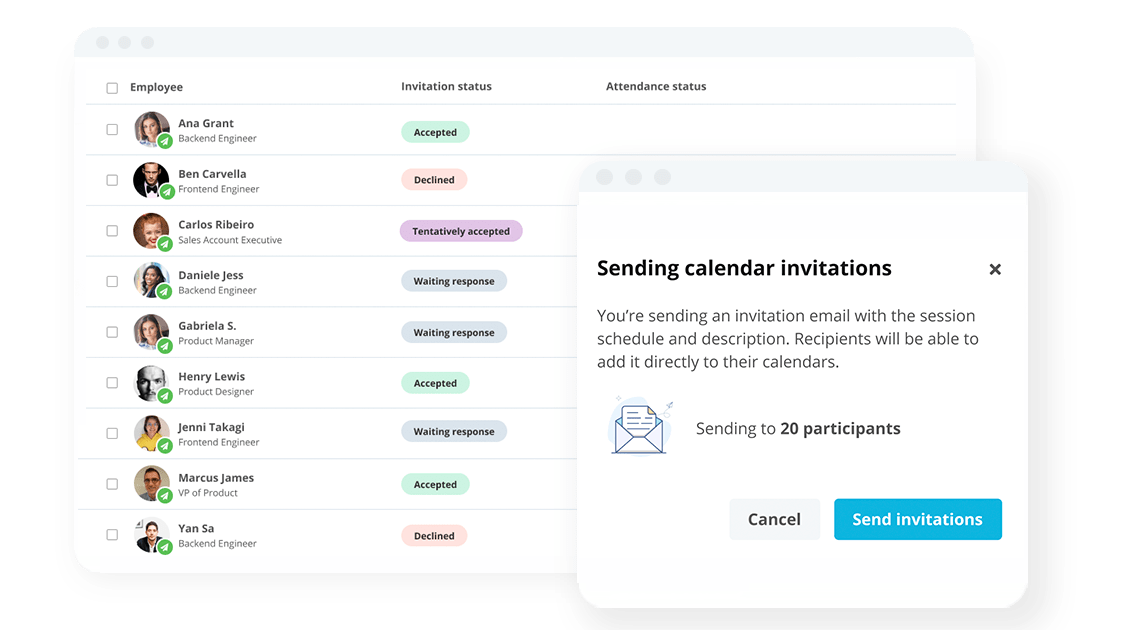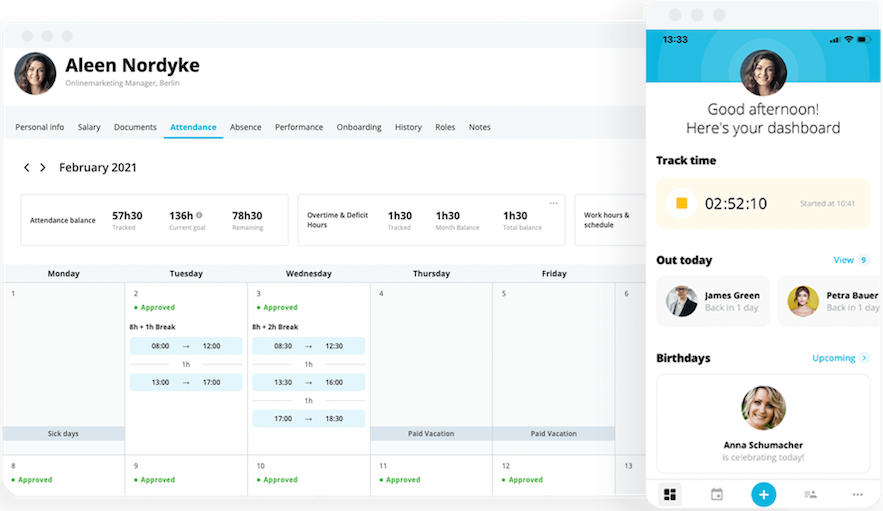
Give the Right Training at the Right Time
Simplify your staff development with centralised training management.
Future-proof Teams With PersonioEmployee Training: Building Proper Employee Training Programs

Is your employee training program helping or hindering your team’s growth? No matter how many employees you have, you should have a comprehensive training program and employee development plan in place. Here’s how to build it.
Building a strategy around your people? Download our guide to doing it today.What Is An Employee Training Program?
An employee training program covers the basics of an organisation’s processes, technical systems, and how a new hire fits into it all.
But, a more developed employee training program should go well beyond that. It should immerse the employee in your workplace culture, align them with the company’s values and mission, and set them up for long-term job satisfaction.
The 6 Major Benefits Of Building An Employee Training Program
Can employee training help thoroughly educate newcomers on your products, processes, and services? Yes, but that’s only skimming the surface of how it — and further employee development — can help your company…
1. It Increases Employee Retention
Today’s workers are looking for companies that encourage employee learning. In fact, 94% of employees would stay with a company for longer if they invested in employee learning.
Grow your training and employee development programs, and you’ll spend less time searching for great employees and more time developing the ones you already have.
2. It Makes For Happier Workers
For Millennials and Gen Z workers, learning and development opportunities are a high priority, and nearly a quarter of them say it’s a top factor in their work happiness.
It makes sense, doesn’t it? After all, if an employee isn’t continually challenged and encouraged to learn new things, their job can grow stale, leading to a lack of motivation and engagement.
3. It Provides Desired Career Growth
Career growth and employee happiness go hand-in-hand — here’s more proof of that: 76% of employees want career growth opportunities, but if they can’t find them at their current company, they move elsewhere. Providing career growth opportunities through skill-building and managerial training can ensure you keep your talent where they are.
4. It Puts More Money In Your Pocket
Employee training programs are an investment — but so is having to retrain and rehire employees that aren’t trained properly the first time.
The cost to replace an employee earning the UK’s average salary of £27,721 could cost you up to £12,000. For a higher-salaried employee, say £60,000, that could go up to £20,000.
In the long run, it’s more cost-efficient to invest in your current employee development.
5. It Keeps Employees Up-To-Date
You can’t move forward as a company unless you’re training with the future in mind. Arming your employees with training on the latest industry trends and technologies will make them more skilled and knowledgeable workers, enabling them to create industry-leading results for your company.
6. It Attracts High-Calibre Talent
All that industry-leading work you’re pumping out? That’s going to attract the type of high-caliber talent you need to improve even further. Provide both skill-building training programs and managerial training for your employees, and you’ll be able to build out a quality team from the top down.
Develop Staff With Ease

Track training attendance, progress and compliance across your organisation from one central, easy-to-use tool.
Future-proof Teams With PersonioHow Do You Choose The Best Training For Employees?
There are several different ways you can structure and source your training programs and employee development initiatives. Here are a few of the most common types of training for employees and when to apply them.
Training Type | Best For | Major Advantage | Major Drawback |
|---|---|---|---|
Internal-Led Training | Companies that need training tailored to their specific needs. | Easily customisable to your company and your unique challenges. | Could take away time from other important company initiatives. |
Outsourced Training | Basic training needs on a generic topic. | Expert-level materials and training from professionals. | Could be more generic or could cost more money. |
Individual Training | Remote companies who want to build out personalised learning paths. | Customise your employee’s learning path to their role, skills, and goals. | May take far too much time and effort in a company of growing size. |
Group Training | Collaborative teams and cross-company training programs. | Encourages more communication and can build better teams. | Often has to surround a very generic or generalised topic to apply to everyone. |
Skill-Building Training | Helping employees develop hard skills in the workplace. | Employees will be able to apply training to their day-to-day work. | May be too niche and may only apply to a handful of employees. |
Training for Leadership | Potential leaders and those who want to improve their managerial skills. | Helping leaders become better managers in your organisation. | Depends on the amount of leaders you have (and the time they have). |
5 Steps To Building An Employee Training Program
To build a proper employee training program, you have to go beyond what you want your team to learn and explore the ‘why’ behind it.
From there, you can set related goals for the training and build a layered program that helps your employees learn, grow, and thrive at your company.
1. Determine Your Training Needs
Start by reviewing previous employee assessments to identify where employees are falling short and why. This skills gap analysis will help you determine what you need to focus on in your employee training, which will define the scope of training and employee development they need.
Consider:
Do employees not understand your programs or processes?
Are they unclear on your company’s mission, product, or service?
What skills can they learn to do their jobs easier, faster, or better?
If there’s low morale or motivation, can behavioural training improve it?
Source the best talent around

Design career pages, create job ads and publish them on more than 600 portals with just one click. Say hello to seamless recruitment with Personio.
Find the Talent You Need2. Set Your Goals
Consult with leadership and department heads to determine your goals for the training. Setting goals is an important part of building a training program, no matter where the employee is in their employment.
For example, goals for a new employee who’s completing onboarding and orientation would include familiarising themselves with your product/service, tools, systems, processes, and company mission or values.
Other goals may include:
Gaining a certain degree of expertise on a topic.
Passing a mandatory course.
Improving their work performance within six months.
3. Consult Your Team
Consult employees to see what training they’re interested in or feel they’re lacking. What would make them feel more confident in their roles? What programs or tools could they learn to be more efficient or productive?
Most workers are eager to learn and want to be involved in their employee development journey. Listen to their needs and desires, build training programs they’ll actually enjoy, and you’ll retain them for longer.
4. Build Your Training With Layers
A layered training approach takes a semi-custom approach to employee development. It focuses on training the employee when and how they need it most.
Layer | How It Works |
|---|---|
Shared Knowledge | It starts with a base level of training that covers all of the information everyone at the company should know. This shared knowledge should be very easy for all employees to access when they need it. |
Performance Support | You can then build on that basic training as needed. For example, the employee may need to move to the next layer of training, which is performance support. Here, they receive training on how to improve their skills or complete a certain task. |
Continued Reinforcement | This layer of training is used to help employees remember specific training or instructions through repetition and memory-building exercises. It may not be needed for every employee, but it can help reinforce positive behaviours, especially around safety and compliance. |
Manager Support | If you’re training a member (or potential member) of leadership, they may skip right from layer one to layer four. This training helps them build soft skills like communication, listening, or decision-making. It could also include day-to-day coaching from the HR or L&D team. |
On-Demand Training | On-demand training provides guidance and upskilling opportunities to an employee the moment they need it. It’s typically delivered through videos, online courses, and quick quizzes that employees can access anywhere and anytime. |
Formal Training | Formal training may include compliance training, diversity and inclusion training, or other company-wide training that typically requires more time and often disrupts employee workflow. |
5. Assess and Evolve
At a minimum, you should review your employee training programs and results annually to assess their effectiveness. If you’re not hitting the goals you set, consult with employees and leadership to see what they’re struggling with, identify weak points in the training, and revise the program.
Get Inspired By These 5 Great Employee Development Programs
To cap things off, let’s take a look at five unique training and development programs that companies have created to support their employees and community:
Etsy: Etsy School
Etsy, an e-commerce platform for independent makers, encourages its employees to host classes and workshops for their peers in Etsy School. They’ve hosted everything from juggling and city biking classes to courses like "Mindfulness 101” and “Feminism and Technology.”
This approach to employee learning and development may be a bit unorthodox, but it’s also wildly successful in helping their team build deeper, more meaningful connections within their company.
Culture Amp: Coaching For Everyone/Learn Yourself Up
Culture Amp’s learning and development programs are focused on helping employees grow just as quickly as the company. They’ve gone beyond traditional L&D initiatives by creating two programs that ensure every employee has access to developmental opportunities:
Through their Coaching For Everyone program, every employee (once they hit the nine- to 12-month employment mark) gains access to sessions with an executive coach or life coach to help them envision and reach their personal, professional, or spiritual goals.
In their Learn Yourself Up program, Culture Amp gives their employees even more control of their development by allocating $1,000 to each person every year, which they can invest in any training they see fit without having to get corporate approval.
Salesforce: Pathfinder Training Program/Trailhead Military
At Salesforce, they’re investing in employee training, even for those who aren’t employees:
Their free Pathfinder training program, cofounded by Salesforce and Deloitte, helps trainees build the technical and business skills needed to pursue a career at Salesforce. It includes 200+ hours of learning, Salesforce credentials, and mentorships.
Salesforce has also invested in a training program specifically for military veterans and military spouses called the Trailhead Military program. It’s a free, self-paced program that’s completely virtual and is designed to help their registrants upskill and start a new career in tech through accessible training.
